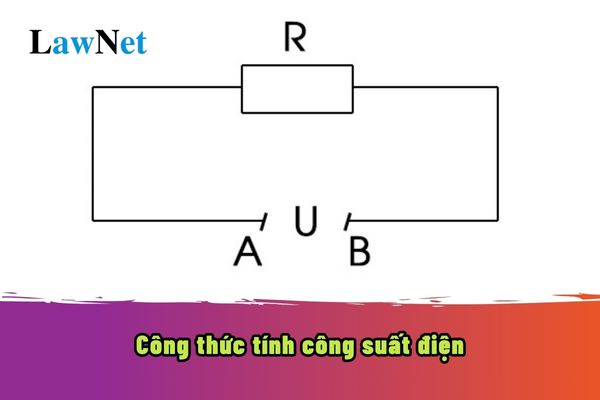What is the formula for calculating electrical power? How to calculate electrical consumption in kWh?
What is the formula for calculating electrical power? How to calculate electrical consumption in kWh?
Formula for calculating electrical power
Electrical power is a quantity that characterizes the rate of energy consumption by an electrical device. The formula for calculating electrical power is expressed as follows:
P = U x I
Where:
P: Power (unit: Watt - W)
U: Voltage (unit: Volt - V)
I: Current (unit: Ampere - A)
This formula reflects the relationship between power, voltage, and current flowing through a circuit segment.
*How to calculate electrical consumption (kWh)
kWh is a unit for measuring electrical energy consumption, commonly used for calculating electricity bills.
1 kWh is equivalent to consuming 1 kW of electrical energy in 1 hour.
Calculation formula:
A = P x t
Where:
A: Energy consumption (unit: kWh)
P: Power (unit: kW)
t: Usage time (unit: hours)
Example: A light bulb has a power of 100W and operates for 5 hours. Calculate the energy consumption of the light bulb.
Convert: 100W = 0.1kW
Calculate: A = P x t = 0.1kW x 5h = 0.5kWh
Thus, the light bulb consumed 0.5kWh of electrical energy.
Other related formulas:
P = A/t: Power is energy consumption divided by time.
P = R x I^2: Power loss on a resistor (R is resistance, I is current).
P = U^2/R: Power loss on a resistor (U is voltage, R is resistance).
*Practical Application:
Calculating electricity bills: Electricity companies use this formula to calculate the amount of electricity payment each household owes.
Choosing electrical devices: When purchasing electrical devices, power is often considered to compare and select suitable equipment.
Designing electrical systems: Electrical engineers use this formula to calculate the necessary power for electrical devices in a system.
*Note: The information is for reference purposes only./.

What is the formula for calculating electrical power? How to calculate electrical consumption in kWh? (Image from the Internet)
When will students in Vietnam study the formula for calculating electrical power?
Based on Section 5 of the general education curriculum for physics issued together with Circular 32/2018/TT-BGDDT, the content to be achieved in the grade 11 physics curriculum is as follows:
Electrical energy, electrical power
- Describe that the electrical energy consumed by a circuit segment is measured by the work done by the electric force when moving electric charges; the power consumption of electrical energy by a circuit segment is the electrical energy consumed by the circuit in a unit time.
- Calculate the electrical energy and power consumption of electrical energy by the circuit segment.
Thus, according to the regulations, the formula for calculating electrical power will be taught in grade 11.
What are topics in the grade 11 physics in Vietnam?
Based on Section 5 of the general education curriculum for physics issued together with Circular 32/2018/TT-BGDDT, the content to be achieved in the grade 11 physics curriculum is as follows:
Topic 11.1. Gravitational field
Concept of gravitational field
- Provide examples proving the existence of Earth's gravitational force.
- Discuss (through illustrations, multimedia documents) to state that: Every mass creates a gravitational field around it; The gravitational field is a force field created by a mass, a form of matter existing around a mass and exerting gravitational force on another mass placed in it.
Gravitational Force
- Describe that when considering the gravitational field at a point outside a uniform sphere, the mass of the sphere can be considered as concentrated at its center.
- Apply Newton's law of universal gravitation F = Gm1m2/r2 for some simple cases of motion in a gravitational field.
Gravitational field intensity
- Define the intensity of a gravitational field.
- From the law of gravitation and the definition of gravitational field intensity, derive the equation g = GM/r2 for simple cases.
- Use the equation g = GM/r2 to assess some simple phenomena related to gravitational fields.
- Describe that at any position near the Earth's surface, within a not very large height range, g is constant.
Gravitational potential and gravitational potential energy
- Discuss (through images, multimedia documents) to define gravitational potential at a point in a gravitational field.
- Apply the equation = - GM/r for simple cases.
- Explain briefly the motion of geostationary satellites, derive the first cosmic velocity formula.
Topic 11.2. Communication by radio waves
Modulation
- Compare amplitude modulation (AM) and frequency modulation (FM).
- List the frequency and wavelength used in different communication channels.
- Discuss to determine the relative advantages and disadvantages of AM and FM channels.
Analog and digital signals
- Describe the advantages of transmitting data in digital form compared to analog form.
- Discuss to determine that voice or music transmission involves analog-to-digital conversion (ADC) before transmission and digital-to-analog conversion (DAC) upon reception.
- Briefly describe the digital transmission system concerning analog-to-digital and digital-to-analog conversion.
Signal attenuation
- Discuss the effect of signal attenuation on the quality of transmitted signals; describe the signal attenuation level calculated in dB and in dB per unit length.
Topic 11.3. Introduction to electronics
Operational amplifier
- Discuss, suggest, select options, and implement projects to explore:
+ Classify sensors according to: working principle, application range, economic efficiency.
+ Working principle of: light-dependent resistor (LDR), thermistor.
+ Working principle of sensors using: light-dependent resistor (LDR), thermistor.
+ Basic properties of ideal operational amplifiers (op-amp).
Output devices
- Discuss, suggest, select options, and implement projects to explore three output devices:
+ Working principle of op-amp - relays circuit.
+ Working principle of op-amp - LEDs (light-emitting diode) circuit.
+ Working principle of op-amp - CMs (calibrated meter) circuit.
+ Design some simple application circuits using output devices.
Sensing devices
- Visit on-site (or through multimedia documents), discuss to determine some main applications of sensing devices and the working principle of sensing devices.

